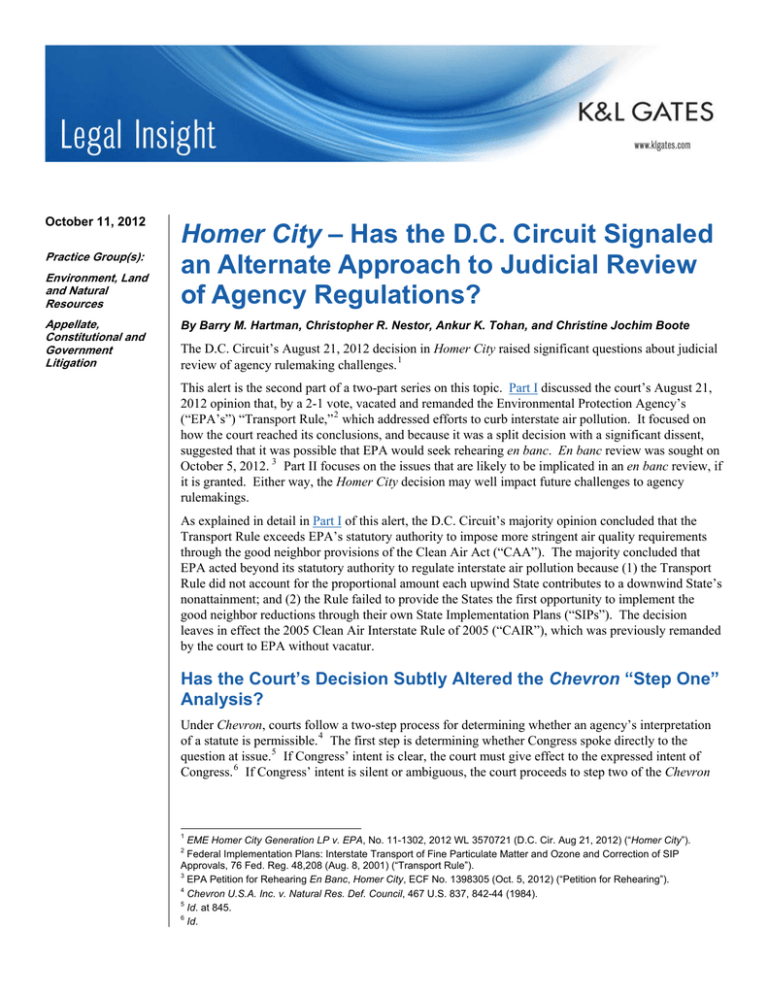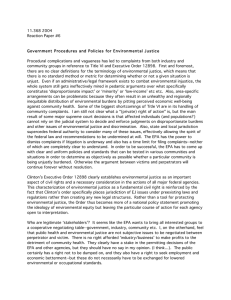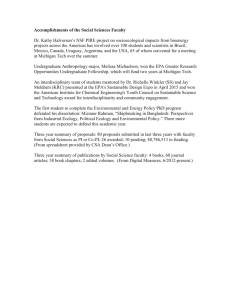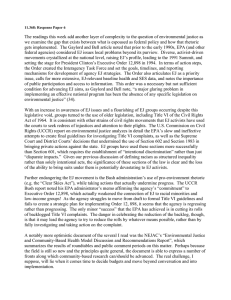an Alternate Approach to Judicial Review of Agency Regulations? Homer City
advertisement

October 11, 2012 Practice Group(s): Environment, Land and Natural Resources Appellate, Constitutional and Government Litigation Homer City – Has the D.C. Circuit Signaled an Alternate Approach to Judicial Review of Agency Regulations? By Barry M. Hartman, Christopher R. Nestor, Ankur K. Tohan, and Christine Jochim Boote The D.C. Circuit’s August 21, 2012 decision in Homer City raised significant questions about judicial review of agency rulemaking challenges. 1 This alert is the second part of a two-part series on this topic. Part I discussed the court’s August 21, 2012 opinion that, by a 2-1 vote, vacated and remanded the Environmental Protection Agency’s (“EPA’s”) “Transport Rule,” 2 which addressed efforts to curb interstate air pollution. It focused on how the court reached its conclusions, and because it was a split decision with a significant dissent, suggested that it was possible that EPA would seek rehearing en banc. En banc review was sought on October 5, 2012. 3 Part II focuses on the issues that are likely to be implicated in an en banc review, if it is granted. Either way, the Homer City decision may well impact future challenges to agency rulemakings. As explained in detail in Part I of this alert, the D.C. Circuit’s majority opinion concluded that the Transport Rule exceeds EPA’s statutory authority to impose more stringent air quality requirements through the good neighbor provisions of the Clean Air Act (“CAA”). The majority concluded that EPA acted beyond its statutory authority to regulate interstate air pollution because (1) the Transport Rule did not account for the proportional amount each upwind State contributes to a downwind State’s nonattainment; and (2) the Rule failed to provide the States the first opportunity to implement the good neighbor reductions through their own State Implementation Plans (“SIPs”). The decision leaves in effect the 2005 Clean Air Interstate Rule of 2005 (“CAIR”), which was previously remanded by the court to EPA without vacatur. Has the Court’s Decision Subtly Altered the Chevron “Step One” Analysis? Under Chevron, courts follow a two-step process for determining whether an agency’s interpretation of a statute is permissible. 4 The first step is determining whether Congress spoke directly to the question at issue. 5 If Congress’ intent is clear, the court must give effect to the expressed intent of Congress. 6 If Congress’ intent is silent or ambiguous, the court proceeds to step two of the Chevron 1 EME Homer City Generation LP v. EPA, No. 11-1302, 2012 WL 3570721 (D.C. Cir. Aug 21, 2012) (“Homer City”). Federal Implementation Plans: Interstate Transport of Fine Particulate Matter and Ozone and Correction of SIP Approvals, 76 Fed. Reg. 48,208 (Aug. 8, 2001) (“Transport Rule”). 3 EPA Petition for Rehearing En Banc, Homer City, ECF No. 1398305 (Oct. 5, 2012) (“Petition for Rehearing”). 4 Chevron U.S.A. Inc. v. Natural Res. Def. Council, 467 U.S. 837, 842-44 (1984). 5 Id. at 845. 6 Id. 2 D.C. Circuit Charts a New Path with EPA’s Cross-State Air Pollution Rule analysis, and determines whether the agency’s interpretation of ambiguous statutory language “is based on a permissible construction of the statute.” 7 In evaluating the Transport Rule, the majority opinion engaged in a detailed analysis of EPA’s calculation of an upwind State’s contribution to a downwind State’s attainment and how much those States would be required to reduce their emissions. 8 The majority explained that the CAA “requires a State to prohibit at most those ‘amounts’ which will ‘contribute significantly’ – and no more.” 9 It concluded that EPA may not require an upwind State to do more to reduce air pollution by more than the amount of its contribution to a downwind State’s nonattainment. 10 Citing the good neighbor provision of the Act, 11 the majority viewed the rule as contrary to the basic requirements of the statute and the court’s precedents: “First, and most obviously, the text of Section 110(a)(2)(D)(i)(I) tells us that the ‘amounts which will . . . contribute’ to a downwind State’s nonattainment are at most those amounts that travel beyond an upwind State’s borders and end up in a downwind State’s nonattainment area.” 12 The good neighbor provision states that an SIP must: (D) contain adequate provisions– (i) prohibiting, consistent with the provisions of this subchapter, any source or other type of emission activity within the State from emitting any air pollutant in amounts which will– (I) contribute significantly to nonattainment in, or interfere with maintenance by, any other State with respect to any such national primary or secondary ambient air quality standard . . . . 13 The majority’s evaluation of the rule expressly relies on a plain reading of the statute and the court’s interpretation of EPA’s authority in prior cases. “Although the statute grants EPA significant discretion to implement the good neighbor provision, the statute’s text and this Court’s decision in Michigan and North Carolina establish several red lines that cabin EPA’s authority. Those red lines are central to our resolution of this case.” 14 What is less apparent from the opinion, however, is exactly which statutory provision provides the foundation for the Chevron step one analysis. In other cases, the plain meaning can be a function of logic rather than strict textualism. The D.C. Circuit has tended toward the latter. 15 Similarly, the court ruled that EPA’s decision to implement the Federal Implementation Plan (“FIP”) without first giving the States an opportunity to implement the good neighbor reductions through their own SIPs violates the plain terms of the statute. The majority concluded that only after EPA has set 7 Id. Homer City at *12. 9 Id. at *14. 10 Id. 11 42 U.S.C. § 7410(a)(2)(D). 12 Homer City at *10 (italics in original, emphasis added). The majority notes in a footnote to this sentence that EPA’s counsel “refused to concede this point” at oral argument. Id. at *10, n. 12. 13 42 U.S.C. § 7410(a)(2)(D) (emphasis added). 14 Id. at *9 (referencing Michigan v. EPA, 213 F.3d 663 (D.C. Cir. 2000), and North Carolina v. EPA, 550 F.3d 1176 (D.C. Cir. 2008)). 15 See, e.g., New Jersey v. EPA, 517 F.3d 574 (D.C. Cir. 2008); Sierra Club v. EPA, 536 F.3d 673 (D.C. Cir. 2008); Environmental Defense v. EPA, 467 F.3d 1329, 1336 (D.C. Cir. 2006); Environmental Defense Fund v. EPA, 167 F.3d 641 (D.C. Cir. 1999). 8 2 D.C. Circuit Charts a New Path with EPA’s Cross-State Air Pollution Rule state-specific emission reduction obligations does a State have an obligation to submit a good neighbor SIP. 16 While acknowledging Chevron step one in a footnote, 17 it is not clear precisely which provisions of the statute provide the clear manifestation of Congress’ intent. It may well be that the majority’s reading of the statute is the only possible construction that makes sense. After all, the majority is using simple logic – air pollution from one State cannot contribute to nonattainment in the other unless it crosses the border. 18 This is not an unprecedented application of Chevron step one, but as noted above, this Circuit tends toward a more textual approach. In dissent, Judge Rogers argues that the plain text of the statute clearly “requires that within three years of EPA’s promulgation of a [National Ambient Air Quality Standard (“NAAQS”)], States shall submit SIPs, and those SIPs shall include adequate ‘good neighbor’ provisions.”19 Judge Rogers argues that: Nowhere does the CAA place a requirement on EPA to quantify each State’s amount of “significant contribution” to be eliminated pursuant to the “good neighbor” provision, let alone include any provision relieving States of their “good neighbor” SIP obligations in the event EPA does not first quantify emission reduction obligations. 20 Further, Judge Rogers argues that the majority overstepped its authority under Chevron: The court’s role is not to “correct” the text so that it better serves the statute’s purposes; nor under Chevron may the court avoid the Congressional intent clearly expressed in the text simply by asserting that the court’s preferred approach would be better policy. The Congress has spoken plainly . . . . 21 Thus, the dissent focuses on whether such a standard is an appropriate application of Chevron step one. No doubt the majority would disagree with Judge Rogers’ characterization of how they applied Chevron step one, and this debate may find its way into en banc review. Regarding the majority opinion that EPA must first give States the opportunity to submit adequate good neighbor SIPs before promulgating the FIP, Judge Rogers notes that “it is extraordinarily unusual for a court to conclude, at Chevron step one, that it must delete mandatory obligations from a statute in order to accord with Congress’s plain intent.” 22 The differences between the majority and dissenting opinions suggest a significant difference of opinion regarding the plain meaning of the good neighbor provisions of the CAA. The majority appears to reinforce what Chevron has always stood for: no deference to the agency, irrespective of the subject matter, where Congress has clearly spoken. However, Judge Rogers’ dissent set forth a path for EPA to follow to argue how the majority opinion may not follow a proper Chevron analysis and should be reheard. 16 Homer City at *15-18. The majority determined that EPA’s interpretation of its FIP authority “is contrary to the text and context of the statute (a Chevron step 1 violation)” and “in the alternative is absurd (a Chevron step 1 violation), and again in the alternative is unreasonable (thus failing Chevron step 2 if we get to step 2).” Id. at *27. 18 See n. 23, below. 19 Id. at *32. 20 Id. 21 Id. (internal quotations omitted). 22 Id. at *33, n. 11. 17 3 D.C. Circuit Charts a New Path with EPA’s Cross-State Air Pollution Rule The majority may have been compelled to provide a detailed discussion of the particulars of the regulation in light of the long history of this particular rulemaking – legislatively, regulatorily, and judicially – and its desire that the next iteration of the rule be consistent with its reading of the statute and the cooperative federalism inherent in the CAA. Ultimately, the debate may boil down to how one bases a conclusion that Congress’ intent is “clear.” 23 But even on the Chevron step two analysis, Judge Rogers argues that it too requires deference to EPA’s interpretation. 24 The majority in contrast argues that even if Congress’ intent was not manifestly clear, EPA’s interpretation is unreasonable, even given the deference afforded agencies in such circumstances. Thus, it is quite possible that if en banc review is granted, the result may be a clarification of the Chevron step one analysis, but the same substantive result under step two of that standard. Was the issue sufficiently raised in the record or is a new standard being suggested? As with all cases of judicial review of agency action, in a challenge to a rule promulgated under the CAA, the challenger is limited to those objections or issues “raised with reasonable specificity during the period for public comment[.]” 25 The purpose of limiting review of an agency’s rules to those issues raised during the rule’s development is to: enforce repose so that the rulemaking process is not crippled by surprise challenges to matters that were rightfully presumed settled, and to guarantee an agency's expert consideration and possible correction of any flaws in its rules before the matter reaches a court. 26 In Homer City, the majority concluded that the administrative record for the rulemaking provided EPA sufficient notice of the issues raised in the legal challenge. In particular, the majority pointed to specific comments submitted during the comment period and to the judicial history undergirding EPA’s application of the good neighbor provision. 27 According to the majority, while EPA may well have been put on notice by virtue of the earlier rulemaking, the fact is, the issue was within the scope of the subject matter and the agency had the opportunity to address it. However, Judge Rogers disagreed with the majority’s decision to allow a challenge to go forward on EPA’s interpretation of its Final SIP rules – i.e., rules promulgated years ago which unambiguously provide that States have an “independent obligation under section 110(a) to submit ‘good neighbor’ SIPs regardless of whether EPA first quantified each State’s emission reduction obligations.” 28 Consequently, Judge Rogers asserts that the challenge should have been barred from review in the Homer City matter. Likewise, Judge Rogers disagreed with the majority’s decision to allow a challenge to go forward on EPA’s two-step approach to defining a significant contribution under the good neighbor requirement, which provides that a State “may be required to reduce its emissions by an amount greater than the 23 See, “How Clear Is Clear” in Chevron’s Step One?, 118 Harv. L. Rev. 1687, 1696, 1698 (March 2005) (noting that “it is not necessary for courts to name the standard of clarity they are employing [at step one] (or even to say explicitly that they are using any standard of clarity at all)”). 24 EPA’s Petition for Rehearing generally follows the points addressed in Judge Rogers’ dissenting opinion. 25 42 U.S.C. § 7607(d)(7)(B). 26 Homer City, at *24 (emphasis in original). 27 Id. at *12-20; *13, n. 18. 28 Id. at *25. 4 D.C. Circuit Charts a New Path with EPA’s Cross-State Air Pollution Rule ‘significant contribution’ that brought it into the program in the first place.” 29 She noted that an objection to that approach was not raised during the current rulemaking proceeding; and furthermore, the issue was not addressed by the D.C. Circuit in North Carolina v. EPA, 531 F.3d 896 (D.C. Cir. 2008), which the majority relies on to reach its conclusion. 30 According to Judge Rogers, a court may not rely on overarching policy statements, the prior history of rulemaking efforts, or what an agency should have known to assume jurisdiction to hear a challenge to a rulemaking. Rather, a court’s jurisdiction is limited to only those issues that were made with sufficient specificity to notify the agency of potential challenges and objections during a rulemaking comment period. Judge Rogers challenges the majority’s reliance on “the long history of EPA’s efforts to implement the good neighbor provision” and a limited number of comments. 31 Likewise, Judge Rogers criticizes the majority for failing to account for the substantive analysis in the cases it cites to advance a more flexible standard for judicial review. In sum, Judge Rogers concludes that the challengers failed to raise their issues with sufficient specificity and that EPA was not in a position to respond to those comments or to revise the rule before it was finalized. 32 What is not clear is whether there this issue is framed here, could have been effectively raised in any prior rulemaking. EPA echoes Judge Rogers’ analysis in its Petition for Rehearing, taking the position that it often does in many cases: that the issues are barred from judicial review. The thrust of EPA’s argument is that the majority overlooked its own precedent related to judicial review of agency rules. That precedent strictly and consistently applied the limits of what issues could be raised to challenge a CAA rulemaking; precedent which, according to EPA, stands for the proposition that agencies must have the first opportunity to address alleged flaws during the rulemaking process. EPA states in its Petition for Rehearing that the majority in Homer City relied on “conjecture and speculation rather than record-based facts.” 33 On the other hand, some of these rulemakings do take years, are challenged and then revised, and sometimes certain issues just are not appropriate for review until a later point in time. This approach could result in some issues evading review entirely. As with the Chevron discussion above, do the differences between the majority and dissenting opinions suggest the court may be adopting a more flexible approach to assessing whether issues were adequately raised during the administrative process to allow for judicial review? Or does the majority’s reference to the comments made in a rulemaking that was unquestionably and inextricably linked to another rulemaking suggest a recognition that agencies must be cognizant of the context in which rulemaking occurs? In other words, must an agency be prepared to account for and defend its determination on issues that evolve over the course of complex rulemakings, where the issue at hand may not be squarely presented until a subsequent rulemaking? If the Homer City decision stands, it may result in additional opportunities to review agency action. However, it could be that the Homer City decision will become an outlier among the main line of cases that shield agencies from challenges that were not specifically raised for review and analysis during the rulemaking. It remains to be seen whether the D.C. Circuit will accept EPA’s Petition for Rehearing and modify its reasoning, but given the number of judges on the circuit who have opined on these issues, and the importance of the subject matter in this Circuit, the likelihood that the petition will be accepted is enhanced. 29 Id. Id. 31 Id. at *13, n. 18, *36-38. 32 Id. at *35-42. 33 Petition for Rehearing, slip op. at 9. 30 5 D.C. Circuit Charts a New Path with EPA’s Cross-State Air Pollution Rule Authors: Barry H. Hartman barry.hartman@klgates.com +1.202.778.9338 Christopher R. Nestor christopher.nestor@klgates.com +1.717.231.4812 Ankur K. Tohan ankur.tohan@klgates.com +1.206.370.7658 Christine Jochim Boote christine.boote@klgates.com +1.202.778.9222 6







